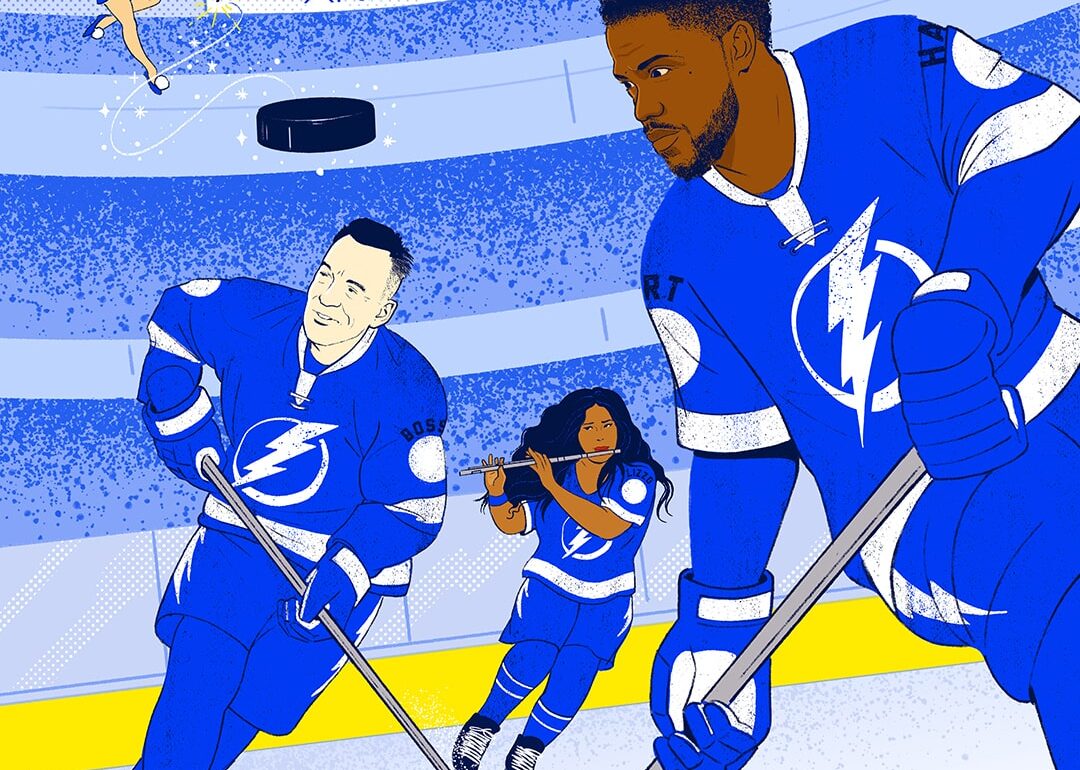By Terry Ward
In the leadup to the goosebump-inducing moment that Latin music’s most legendary superstar took to the stage at Tampa’s Amalie Arena for the Viviendo Tour on a recent Friday night, all of Water Street Tampa was electric with big Marc Anthony energy.
Together with my Cuban-American, Puerto Rican and Tampeño family and friends–full of giddy anticipation and teetering on stilettos for the occasion–we gathered within eyeshot of the arena on the rooftop pool deck of the newly opened Tampa EDITION.
Raising spicy margaritas and mojitos, we swapped stories of Marc Anthony concerts of yore and speculated about whether he’d close with Vivir Mi Vida–his biggest hit and a song the star has said is about living life, being happy and forgetting sadness.
By the time we left the hotel’s bougainvillea-draped pool bar and strolled right across the street to the arena, crowds were dancing to salsa music and reggaeton blasting over speakers in the main plaza, creating a block party atmosphere in the heart of downtown while queuing excitedly for the doors to open.
If the energy outside was electric, inside Amalie Arena it could have lifted the roof.

As the three-time Grammy Award-winning singer stepped on stage to open with his runaway 2022 hit, Pa’lla Voy, the crowd, who hardly needed to be coaxed to their feet for a fiesta, swayed their hips in unison like one massive salsa dancing machine. And they didn’t stop until the show ended with Vivir Mi Vida (we called it).
Less than 24 hours later, I was back at Amalie Arena sporting my Steven Stamkos jersey with my husband and kids in tow, sipping a craft beer and chomping nachos, to cheer the Tampa Bay Lightning to a win over the Buffalo Sabres during one of the team’s 41 home games played here each year.
The complete change in scenery–from the crowd to the event to the whole vibe of the place–couldn’t have been more different than the day prior. But for the 19,092-seat Amalie Arena that hosts more than 160 ticketed events in a calendar year for the roughly 2 million people that walk through its doors, it was just business as usual.
In the six days that followed my weekend’s fun, comedian Adam Sandler took to the stage at Amalie Arena before a sold-out crowd, the Lightning skated back onto the ice for another home game thriller and the Queen of Country, Reba McEntire, crooned her classics.
Between its programming lineup in 2022 and 2023, the arena’s diverse range of entertainment will stage everything from heavy metal bands and Christian pop stars to Bruce Springsteen, The Millennium Tour’s R&B and hip hop acts, Anna and Elsa on skates with Disney On Ice and the toothy velociraptors and Tyrannosaurus rex of Jurassic World Live Tour.

What’s behind the momentum that’s helping Amalie Arena draw some of the most diverse acts in the country right now, I wondered. Not to mention–how had the place gone from sultry concert palace to rowdy ice rink while I was sleeping?
I sat down to chat with three of the key players from Vinik Sports Group–which operates and manages Amalie Arena–to find out how some of the best live entertainment in the country comes together under Tampa’s most exciting roof.
CURRENT: Talk to us about Tampa right now and Amalie Arena’s position at the heart of Water Street Tampa. What’s the vibe?
Kevin Preast (Chief Venue Officer for Vinik Sports Group, which manages and operates Amalie Arena): The city has exploded over the course of the pandemic. People were leaving other areas to come down here and live where people vacation. We’ve gotten bigger, better, faster and stronger. And as a byproduct of that, the city has gotten younger, more diverse and with more disposable income.
Tampa is now a full-fledged top 10 market that needs to have the full selection of entertainment offered to it. And that’s the market Amalie Arena serves.
The arena was built to be an epicenter of community, and as Water Street Tampa continues to evolve around us, it’s very exciting. We were kind of out on an island before here in the downtown area, along with the Florida Aquarium. Now there are more places to stay, eat and shop. It makes the area much more of a destination and that only accentuates where we are and what we can bring to town.

CURRENT: Speaking of that, how has Amalie Arena’s programming evolved alongside the city?
Kelli Yeloushan (Senior Director of Event Management at Vinik Sports Group): I think our event mix was pretty diverse before, but it’s really intensifying from a diversity standpoint. Our Latin market is on fire right now, and we’re looking at what future we have in other areas, too, like the Filipino market, among others.
So many people have moved to Tampa from spots like L.A. and New York and we’re seeing it with the success of how many tickets are being sold to different shows and how much more diverse the city is as a whole through ticket sales. That, in turn, gives us the ability to book more of those artists.
Our event mix is across the board—basketball, hip hop, a University of Florida game, country music—there’s not really any area we aren’t touching as far as a programming standpoint.
CURRENT: What has the reaction from out-of-towners been to the Tampa and Amalie Arena experience?
Yeloushan: I’m already seeing the change in how Water Street Tampa affects our events. The promoters and artists coming in are wanting to go outside and look around. They’re saying, wow, last time I was here there were none of these buildings. I feel the visitors who aren’t local are opening their eyes to this idea that Tampa is doing good things right now. We can all see it with our eyes here that Tampa is really changing, and they can see it, too. We’re a boom town, people are talking about Tampa. And it’s amazing to watch agents and promoters come in and realize it, too, and say oh, yes, we need to bring new artists to this city.

CURRENT: Is there ever a down moment or season where you can kick back and take a breather?
Preast: The arena never stops. This building is never not occupied with staff, whether that’s conversion staff flipping it for the next event, security staff, cleaning staff, marketing people here late and early. This is a 24/7 endeavor.
In November and December, we [hosted] something like 45 to 48 events over a 60-day period. Summer is usually leaner with major tours going outside or performing at stadiums. But there are always those who want to come into the air conditioning and get out of the rain, too.
As for who’s coming to the arena, lots of our ticket buyers are coming in from out of state. They’re going to a show, a game—maybe playing golf, going to the beach or Busch Gardens—then coming back and doing another game. People want to come to Tampa and we get to be the beneficiary of that, as long as we’re hosting something that entertains them.
CURRENT: How do you convert the building so quickly to keep up with such a busy and diverse lineup of events?
Rhett Blewett (VP of Facilities Operations, Assistant GM for Vinik Sports Group): It really starts with our culture of being a team. Facility services is the group that helps with flipping a building. We don’t remove the ice after every hockey game like some people might imagine, we just cover it and make some configurations with the seating. A lot of the process is mechanical, but so much of it is manpower, too.


To help our building stay humming, help maintain it on a daily basis, help extend the life of it, my team includes full time carpenters, plumbers, electricians, HVAC techs, grounds crew, housekeeping staff…we have two full time employees specialized in ice maintenance, too.
When flipping the arena from a hockey game to a concert, it starts right when the horn sounds and we’ve won the game. People naturally start migrating to the exits, we don’t rush them out, we let them enjoy the moment.
The process of cleaning up is the first phase of converting things, and it really starts with our guest experience staff. The ushers help us collect all of our recyclables. They really hop in and help knock some time off our housekeeping crew’s cleaning process. It can take seven or eight hours to clean up, all through the night. I always joke it’s like little gnomes come out and the building gets turned over and cleaned.
Next, we cover the ice with synthetic insulation materials to create a work space. These deck boards are almost like foam pressed really hard together. It takes about an hour for our team to cover the ice, laying it right on top. It goes together like a puzzle. Then it’s time to set up for the show. A lot of tours nowadays carry their own stage with them, which we love. If we are building a stage, it adds a lot of time.
I love seeing the front of house at the arena, talking and meeting people, but I fell in love with the process of building things up and tearing them down. And for going from a game to a concert and then back, it’s almost like building a house all in one day and tearing it down. It’s pretty exciting.

CURRENT: When do you breathe that final sigh of relief that everything is good to go before an event?
Yeloushan: If it’s an extremely large-scale show and we know it’s going to be tricky to be built and ready to go before doors open, it might be that moment when I see the chairs being set down on the floor. It’s a signal that the stage and production are ready to go. It tells us we’re good, we’re moving, we’re going to make doors.
But the real moment of joy comes when I see the fans. Like when Marc Anthony came out. It’s really just hearing the fans and their reactions when an artist they love takes to the stage. I remember hearing everyone cheer for Adam Sandler, too.
The memories for the fans are the really big moments that make everything we do to get there worth it—being able to help create those memories.
And in Tampa, this is the moment, too. It’s the time. I think there’s so much more to come with what we’re going to see here in the next year, five years and onward.


